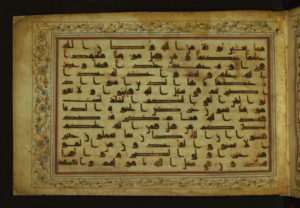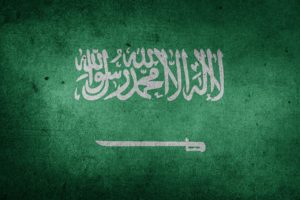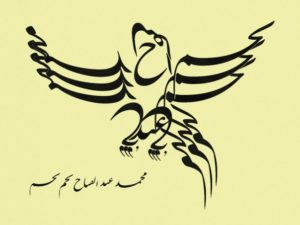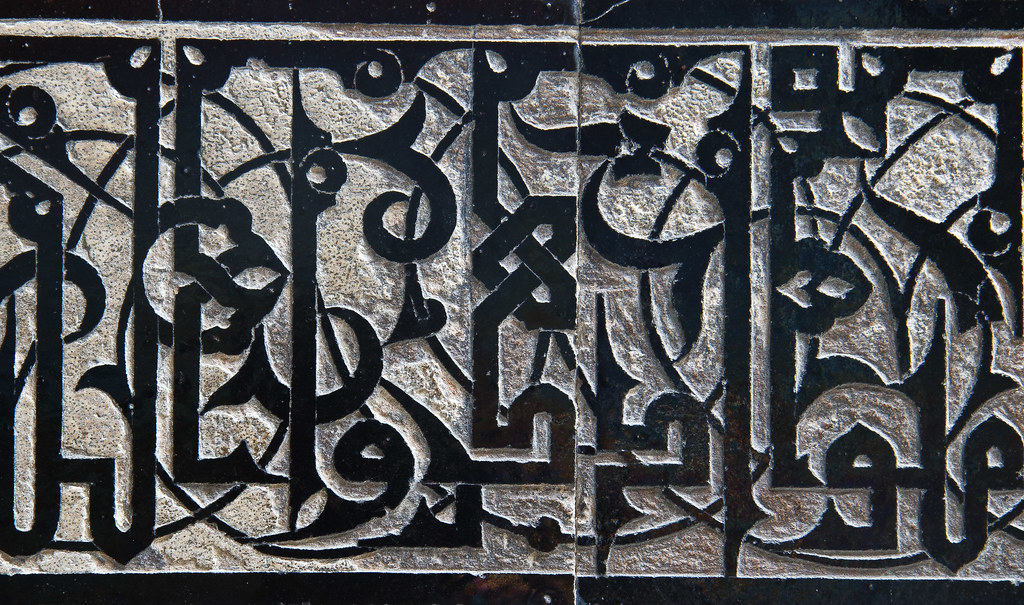2020 is the Year of Arabic Calligraphy. Learn the calligraphic scripts to celebrate the culture of calligraphy
The art of calligraphy is an ancient form of expression. The soul reflects the fonts while the spirit takes the shape of words.
Kufic Calligraphy
The Kufic script is the oldest form of the Arabic script. It appears to be a modified form of the Nabataean script (1st century BC -1st century CE).
The style emphasizes rigid and angular strokes. The ancient script consisted of 17 letters without diacritic dots or accents. The diacritical markings were added during the 7th century to help non-Arab readers with the pronunciation of the Qur’an and other Arabic scripts. In this process, the number of letters was increased to 28.
The style later developed into several varieties. The Kufic fonts include floral, foliated, plaited, interlaced, bordered and squared styles.
The inscriptions on ornamentals and stone carving exist mostly in Kufic font. Also, the inscription in the dome of the rock is in the Kufic Script.

Naskh Calligraphy
With the spread of Islam, Kufic script evolved into Naskh in the 10th century. This font is widely used in the Quran, official decrees, and private correspondences.
Ibn Muqla is regarded as the inventor of the Naskh script. Within a short span of time, the font became so popular that it was used as the regular Arabic print.
Naskh is written with short horizontal stems and vertical depth above and below the medial line. The curves are full and deep, the uprights are drawn straight and words are generally well-spaced.
There are 03 variations of the font:
-
- Thuluth: The font was established in the 10th century by Ahmad Tayyib Shah. The script is used for the inscriptions, titles, headings, and emblem in books. Thuluth means “third” in reference to the x-height, which is one-third of the Alif
- Reqa: The handwriting style is derived from the Naskh and thuluth scripts. The font is simple with short strokes and small flourishes. The curves are densely structured and the letter Alif is never written with barbed heads
- Muhaqqaq: It’s considered the most beautiful and difficult script. It is largely restricted to short ayahs and phrases

Diwani Script
Diwani is a cursive style of Arabic calligraphy. The script gained its popularity during the reign of Suleyman I The magnificent (1520-1566) in the Ottoman Empire. A Diwani text represented the authority of the Sultan and the Ottoman state.
Spaces between the letters are narrow and lines ascend upward from right to left. There are no vocalization marks in Diwani.
It was generally used in the diwan and council, or in the writings of all the royals decrees, endowments, and resolutions.
There are two subdivisions of the Diwani script.
- Riq’a Diwani: This script is written without any decorations. The lines drawn are straight and the lower parts are curved
- Jeli Diwani: Also known as the clear style, the handwriting is distinguished by the intertwining of its straight line from top to bottom. It’s decorated to appear as one piece. Since the script of Jeli Diwani is difficult to write, hence it’s difficult to master

Modern Calligraphy
In the mid 20th century, the Middle East and North Africa started a movement to transform Arabic art into modern art. The movement was named as Hurufiyyah Movement, derived from the word ‘huruf’– the letters of the alphabet.
It was an aesthetic movement to keep the spirit of Arabic calligraphy alive in modern times. By combining ancient and modern art, the calligraphers developed an Arabic visual language. This kept the sense of national identity and coherence alive.
Modern calligraphy exists in many forms.
-
- Calligraffiti. Modern calligraphy was also highly influenced by Western art. This resulted in the form of calligraffiti. Calligraphers used Calligraffiti on the public buildings to convey politico-social messages
- Zoomorphism. Zoomorphism is a Greek word meaning ‘animal’. In Zoomorphic calligraphy, animals are used as the visual motif. This style allows artists to stylize animal forms and designs

2020 will be the celebration of the culture of calligraphy in Arabian and Saudi history. In order to celebrate the Year of Calligraphy, the Ministry of Culture will organize a number of events and activities to promote Arabic calligraphy.
It’ll encourage the interest in calligraphy at the public and private levels. Also, these efforts aim to inspire aspiring calligraphers.
Celebrate the year of Arabic calligraphy. To stay updated with the calligraphy events and much more, download the Hala Yalla app on Android or iOS
